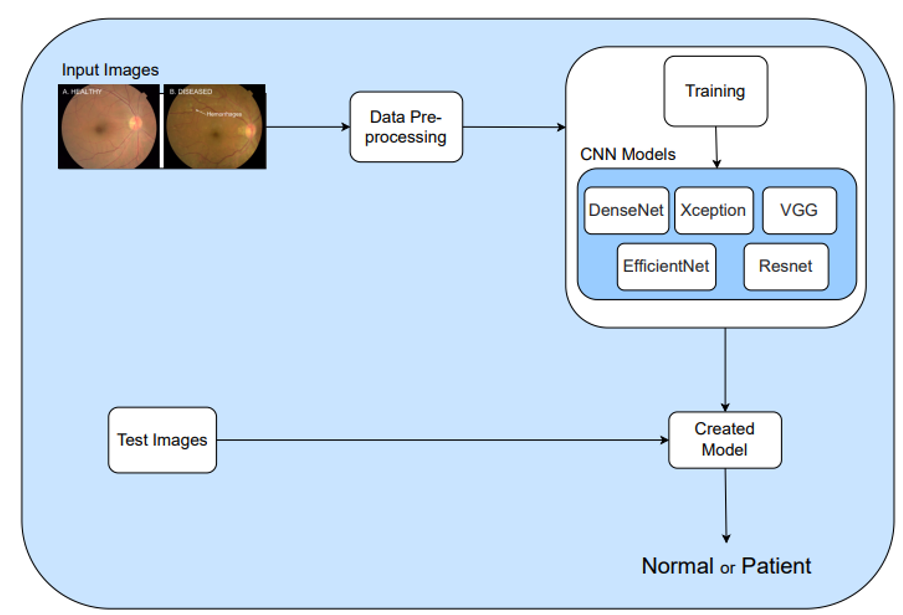Detection Of Cataract, Diabetic Retinopathy and Glaucoma Eye Diseases with Deep Learning Approach
DOI:
https://doi.org/10.58190/imiens.2023.11Keywords:
Classification, CNN, Eye-disease, EfficientNet, Retinal FundusAbstract
Eye diseases are one of the serious health problems affecting human life. Cataract, diabetic retinopathy and glaucoma eye diseases cause visual impairment and cause irreversible eye defects. Throughout human life; genetic, age and environmental factors affect people's eye health. Detection of the disease plays a critical role in order to apply the right diagnosis and therefore increase the quality of life of the patient. With the developing technology, artificial intelligence can detect eye defects and therefore whether there is a disease or not. This study aims to develop solutions for detecting an important health problem such as eye health by using deep learning models. In the related study, Convolutional Neural Networks models, one of the deep learning types are used. The data set used for disease detection includes a total of 2748 Retinal Fundus images taken from 1374 normal individuals and 1374 different disease groups. In order to compare the classification performances and to achieve better performance, a solution to the disease detection problem was sought by using a total of 5 different Convolutional Neural Networks architectures. These are DenseNet, EfficientNet, Xception, VGG, Resnet. For the validity of the approach, it was tested using the 10-fold cross-validation technique. Accuracy, Recall, Precision, F1-Score, and Matthews’s coefficient correlation metrics were used as performance evaluation criteria. When the classification performances were examined, the results obtained with the EfficientNet architecture were measured as 94.88%, 94.88%, 95.02%, 94.88%, 89.89% for Accuracy, Recall, Precision, F1-Score, and Matthews’s coefficient correlation metrics. In this context, the best classification performance was obtained with the EfficientNet architecture.
Downloads
References
World Health Organization (2019), https://www.who.int/news-room/newsletters, (Last Access: 02.04.2023)
https://www.iapb.org/learn/vision-atlas/magnitude-and projections/child-eye-health/ (Last Access: 01.02.2023)
Malik, S., Kanwal, N., Asghar, M. N., Sadiq, M. A., Karamat, I., & Fleury, M. (2019). Data driven approach for eye disease classification with Machine Learning. Applied Sciences, 9(14), 2789. doi:10.3390/app9142789.
R. N. Van Gelder, M. F. Chiang, M. A. Dyer, T. N. Greenwell, L. A. Levin, R. O. Wong, and C. N. Svendsen, “Regenerative and restorative medicine for eye disease,” Nature Medicine, vol. 28, no. 6, pp. 1149–1156, 2022.
Q. Abbas, “Glaucoma-deep: Detection of glaucoma eye disease on retinal fundus images using Deep Learning,” International Journal of Advanced Computer Science and Applications, vol. 8, no. 6, 2017.
L. Jain, H. V. Murthy, C. Patel, and D. Bansal, “Retinal eye disease detection using Deep Learning,” 2018 Fourteenth International Conference on Information Processing (ICINPRO), 2018.
Batuhan Metin, Bahadır Karasulu, ‘Derin Öğrenme Modellerini Kullanarak İnsan Retinasının Optik Koherans Tomografi Görüntülerinden Hastalık Tespiti’, 2022, 9 – 19.
R. Sarki, K. Ahmed, H. Wang, Y. Zhang, and K. Wang, “Convolutional neural network for multi-class classification of Diabetic Eye Disease,” ICST Transactions on Scalable Information Systems, p. 172436, 2018.
M. J. Umer, M. Sharif, M. Raza, and S. Kadry, “A deep feature fusion and selection‐based retinal eye disease detection from oct images,” Expert Systems, 2023, doi: https://doi.org/10.1111/exsy.13232.
R. Gargeya and T. Leng, “Automated identification of diabetic retinopathy using Deep Learning,” Ophthalmology, vol. 124, no. 7, pp. 962–969, 2017, doi:doi.org/10.1016/j.ophtha.2017.02.008.
N. Jmour, S. Zayen, A. Abdelkrim, “Convolutional neural networks for image classification”, Conference: 2018 International Conference on Advanced Systems and Electric Technologies (IC_ASET).
D. Olcer and C. B. Erdas, “Detection of visual impairment from retinal fundus images with deep learning,” 2022 Medical Technologies Congress (TIPTEKNO), 2022.
H.-C. Shin, H. R. Roth, M. Gao, L. Lu, Z. Xu, I. Nogues, J. Yao, D. Mollura, and R. M. Summers, “Deep convolutional neural networks for computer-aided detection: CNN Architectures, dataset characteristics and transfer learning,” IEEE Transactions on Medical Imaging, vol. 35, no. 5, pp. 1285–1298, 2016.
Ö. İnik ve E. Ülker , "Derin Öğrenme ve Görüntü Analizinde Kullanılan Derin Öğrenme Modelleri", Gaziosmanpaşa Bilimsel Araştırma Dergisi, 6, 3, ss. 85-104, 2017.
E. J. Humphrey and J. P. Bello, “Rethinking automatic chord recognition with Convolutional Neural Networks,” 2012 11th International Conference on Machine Learning and Applications, 2012.
G. Huang, Z. Liu, L. Van Der Maaten, and K. Q. Weinberger, “Densely connected Convolutional Networks,” 2017 IEEE Conference on Computer Vision and Pattern Recognition (CVPR), 2017.
Simonyan, K., & Zisserman, A. (2015). Very deep convolutional networks for large-scale image recognition. 3rd International Conference on Learning Representations, 64 ICLR 2015 - Conference Track Proceedings, 1–14.
K. He, X. Zhang, S. Ren, and J. Sun, “Deep residual learning for image recognition,” 2016 IEEE Conference on Computer Vision and Pattern Recognition (CVPR), 2016.
F. Chollet, “Xception: Deep learning with depthwise separable convolutions,” 2017 IEEE Conference on Computer Vision and Pattern Recognition (CVPR), 2017.
https://data.mendeley.com/datasets/4k64fwnp4k/3, (Last Access: 07.08.2022)
https://www.kaggle.com/datasets/linchundan/fundusimage1000, (Last Access: 07.08.2022)
https://www.kaggle.com/datasets/gunavenkatdoddi/eye-diseases-classification, (Last Access: 07.08.2022)
https://www.researchgate.net/figure/A-generic-CNN-Architecture_fig1_344294512 (Last Access: September 2020)
Brownlee, J. (2021). How to Use K-Fold Cross-Validation for Model Evaluation. Machine Learning Mastery. https://machinelearningmastery.com/k-fold-cross-validation/ (Last Access: 07.04.2023)
Balaban, M. E., & Kartal, E. (2015). Veri Madenciliği ve Makine Öğrenmesi Temel Algoritmaları ve R Dili ile Uygulamaları. Çağlayan Kitabevi, İstanbul.
Kohavi, R., & Provost, F. (2016). Glossary of Terms. November. doi:10.1023/A:1017181826899.
Tan, M., & Le, Q. V. (2019). EfficientNet: Rethinking model scaling for convolutional neural networks. In International Conference on Machine Learning (pp. 6105-6114).
Batuhan Bulut, Volkan Kalın, Burcu Bektaş Güneş, Rim Khazhin, ‘Classification of Eye Disease from Fundus Images Using EfficientNet’, APRIL 3, 2022.
R. H. Paradisa, A. Bustamam, W. Mangunwardoyo, A. A. Victor, A. R. Yudantha, and P. Anki, “Deep feature vectors concatenation for eye disease detection using fundus image,” Electronics, vol. 11, no. 1, p. 23, 2021. doi: https://doi.org/10.3390/electronics11010023.
K. AĞCA and H. TAKCI, “Hibrit Bir Model Oluşturarak Diyabetik Retinopati Sınıflandırılması,” European Journal of Science and Technology, 2022. doi: 10.31590/ejosat.1112980

Downloads
Published
Issue
Section
License
Copyright (c) 2023 Intelligent Methods In Engineering Sciences

This work is licensed under a Creative Commons Attribution-ShareAlike 4.0 International License.






